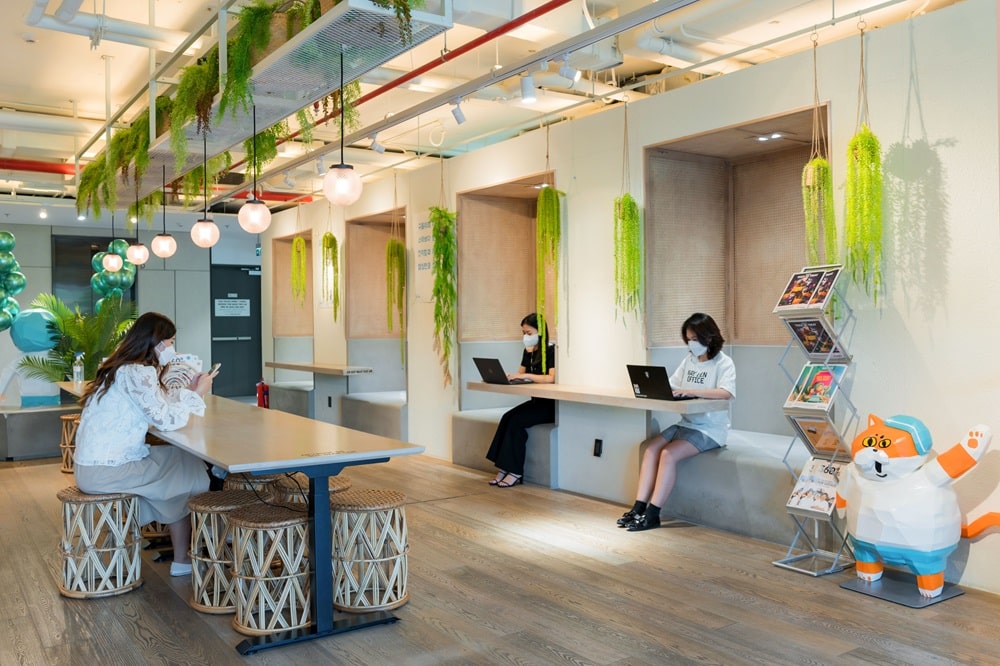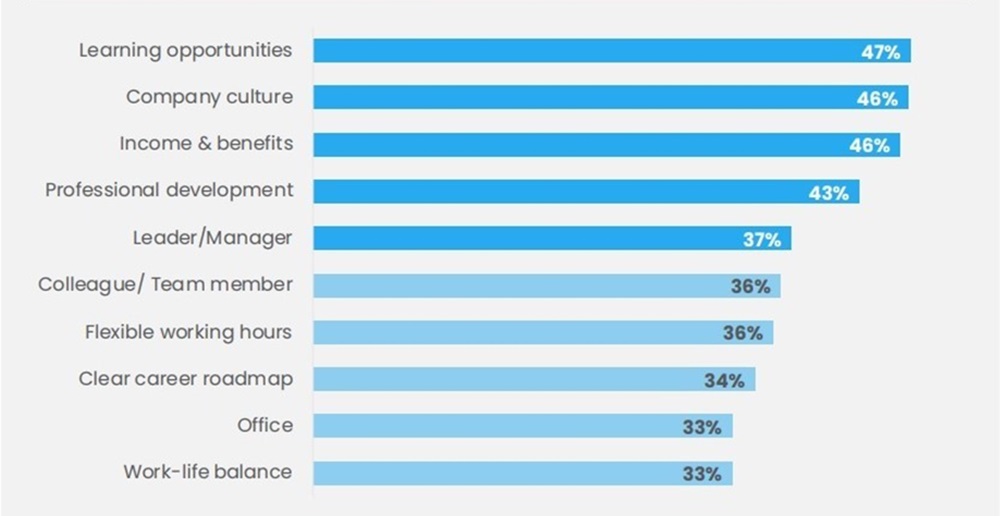Are Hybrid Work and Remote Work models different?

In the context of an increasingly transforming work environment, the emergence of Hybrid Working and Remote Work models has raised many questions about the differences between them. Although both represent the trend of flexible working, are they similar concepts or are there important characteristics that set them apart? Join Onehub Saigon to learn about the unique characteristics of each model and how to choose the right working model for your business.
How are Hybrid Work and Remote Work different?

The difference between Hybrid Working and Remote Work models
Hybrid Working Model
The Hybrid working model is simply a combination of working in the office and remotely, depending on the employee’s schedule. This is a model that is being adopted by many businesses, especially during stressful times of the pandemic, and seems to be becoming a major trend for organizations.
In the Hybrid Working model, employees can flexibly choose to work from home and come to the office on certain days. The combined working model brings convenience, helping employees freely choose their working time and space, optimizing benefits for both individuals and the business.
Hybrid Work working environment brings joy to employees, creates a sense of trust and improves the work-life balance. As a result, work efficiency is enhanced, and work progress achieves the expected results.

Hybrid Working model combines office and remote work
Remote Work model
Unlike the Hybrid Working model, the Remote Work model allows employees to work entirely from any location they choose, without the need for a traditional office, as long as they complete the assigned work on time. Hybrid Work requires employees to arrange to work remotely as well as be present at the office according to the company’s specified schedule.
The Remote Work model is a flexible approach that allows people to escape the traditional atmosphere of working in the office. Specifically, it is based on the idea that work can be completed anywhere and at any time.

The Remote Work model involves working entirely from a distance
Instead of dealing with a daily commute to the office, remote workers can easily and successfully execute projects from locations such as home, coffee shops, or coworking spaces of their preference. This allows individuals the freedom to organize and schedule their working time to make the most of personal autonomy.
Read more: What should be noted when renting an office space?
Choose a working model suitable for your business
It is impossible to judge whether the Hybrid Working or Remote Work model is the best choice. Instead, both models have their advantages and disadvantages. Choosing the right working model will help businesses optimize costs and improve work performance for employees. Below are some suggestions to help businesses choose the suitable working model:
What to do first?
When you’re considering the working model for your team, the first thing to consider is the type of work that employees are performing. It is necessary to consider the ultimate goal of the work which is to complete a set task. Instead of focusing on the job position, focus on how to achieve the business goals set by the company.

Choosing the right working model can help businesses optimize costs and improve working efficiency
Your business has many positions and employees in many different roles. Separate those who need to work full-time (those working with physical equipment) and those who have more flexibility. Then, focus on the remaining employees, does their job require immediate collaboration or should they concentrate on their individual projects? Understanding these factors is essential for your business to decide on the most suitable working model for your employees.
Read more: Office relocation trends towards suburban areas – Decentralization
Issues related to employees
The location of team members plays an important role when you’re considering a work model. When employees live close to each other, instead of bringing them to the office regularly, businesses should create conditions for them to collaborate directly. However, geographical location is not the only factor to consider. You also need to ask questions about where you want to find talent.

Employees can collaborate directly if their locations are close to each other
For example, if your business is located in a large area like District 1 or city centers, finding quality employees willing to come to the office at least part-time may be easier. Conversely, if you operate in a smaller area or in a specialized industry such as in Nha Be, accessing a larger talent pool from a remote work model may be a more suitable option.
How can businesses support remote work for employees?
To support a fully remote or hybrid work model, what tools and technologies do you have or are willing to implement? Your answers will help determine the most suitable model for your operation.
For example, for remote teams, you can provide an allowance for each employee to set up a home office. This allows them to buy necessary equipment and supplies such as cameras, desk chairs, computers, etc. to ensure everyone has conducive and equitable working conditions.
However, maintaining support and fairness for hybrid teams may be more challenging. Because some employees who work on-site and communicate face-to-face with each other, remote employees may be disadvantaged and find it difficult to express their opinions.
Learn more: Reasons why foreign businesses should invest in Vietnam

Remote employees face challenges in exchanging work tasks
This doesn’t mean you shouldn’t pursue a hybrid model, but it will require you to use tools and establish processes to ensure remote workers aren’t overlooked or disadvantaged.
What do your employees desire?
The most important thing that you should not ignore is the opinions and preferences of the company’s members. They will certainly have their views on how they want to work. Listening to your employees will help your business transition to a remote or hybrid work model smoothly.
Various methods can be applied to gather their opinions. If you believe that they are well aware of the strengths and weaknesses of each model, you can simply organize a vote. However, if you think your employees need to have a more thorough discussion about what’s best for them and the company, you can conduct a meeting and explain more clearly how each model affects them.
You should highlight the benefits and challenges of each model, but also ensure that both models are a good fit for your organization’s operational needs. After discussing the needs of the employee and company, you and your team can reach an agreement on the most suitable working model for everyone.

Businesses need to listen to the opinions and preferences of their employees
Implementing the Hybrid Working model does not have many difficulties
Implementing the Hybrid Working model brings many benefits without encountering too many difficulties. The combination of office and remote work not only creates flexibility but also promotes work efficiency and maintains a balance between personal life and work. This model allows employees the freedom to choose a workplace that suits their specific job, while also facilitating creativity and innovation in the work environment.
Moreover, the flexible application of the Hybrid Working model also reduces the burden of traffic and increases employee satisfaction. Although there are certain challenges, such as maintaining a level of interaction and connection within the teamwork with effective management and support, this model is not only feasible but also provides positive working experience for both businesses and employees.
You might be interested in: Office leasing models in Thu Duc City
Survey from DecisionLab
The latest survey has clearly shown that 62% of employees in Vietnam prefer a combination of working in the office and remote working. Among 503 people working in various industries, surveyed in September 2023 by DecisionLab, a partner of YouGov – a market research company in the UK, and The Sentry – the largest social real estate company in Vietnam. Among the survey participants, 43% belong to Generation Z and 50% belong to Generation Y, of which 51% are female.
15% mentioned that they prefer working in the office and 14% chose the flexibility of being able to work anywhere, including at home or in the office. While hybrid work is a popular choice, not everyone is interested in remote work, according to the survey. While 65% of participants said that remote working provides flexibility and reduces stress, 62% said it ensures work-life balance. However, 75% believe that effective remote work requires high concentration and discipline, and 57% face difficulties in building relationships and networks.
When asked about important factors in choosing a workplace, 47% indicated that learning opportunities are the top priority, followed by company culture and benefits and income, both of which reached a rate of 46%.
For Generation Z, those aged 14-26, educational opportunities are the most important factor when choosing a workplace, with 48% of survey participants placing it as a top priority. Meanwhile, half of Generation Y (27-42 years old) consider income and other benefits to be the most important factors.

Statistical table of factors in choosing a workplace according to a survey from DecisionLab
“The announcement shows that only 9% of employees prefer to work remotely only, which shows that people still value the social and professional benefits of coming to the office,” said by Mr. Thue Quist Thomasen, CEO of Decision Lab.
Conclusion
The Hybrid Working and Remote Work models both bring unique opportunities and challenges. The decision to choose a working model requires careful consideration, focusing on the specific nature and goals of the organization. The difference between these two models is not only in how they optimize the workspace but also in how they impact interaction and teamwork. Onehub Saigon emphasizes the importance of flexibility and smart management to create an organized and positive working environment.



